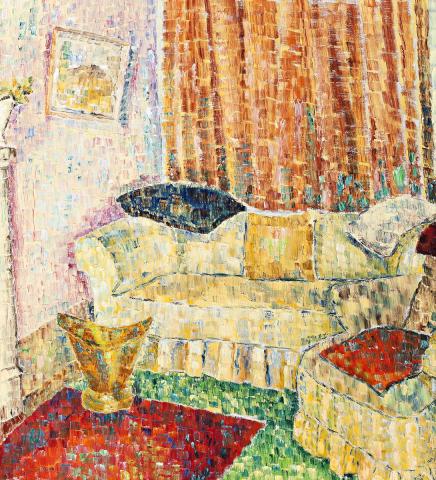SOFA IN THE CORNER, 1962
GRACE COSSINGTON SMITH
oil on composition board
61.0 x 55.0 cm
signed and dated lower left: G. Cossington Smith 62
Macquarie Galleries, Sydney
The Estate of the late James O. Fairfax AC, New South Wales and Bridgestar Pty Ltd, Sydney, acquired from the above in 1964
Exhibition of Paintings: Grace Cossington Smith, Macquarie Galleries, Sydney, 28 October – 9 November 1964, cat. 7
Sofa in the Room, 1960, oil on composition board, 91.5 x 60.0 cm, private collection, illus. in Thomas, D., Grace Cossington Smith, Art Gallery of New South Wales, Sydney, 1973, cat. 74, pp. 59 (illus.), 68
Sofa in the Corner, 1963, oil on board, 33.5 x 26.5 cm, private collection
‘What I dream of is an art of balance, of purity and serenity, devoid of troubling or depressing subject matter, an art which could be for every mental worker, for the businessman as well as the man of letters, for example, a soothing, calming influence on the mind, something like a good armchair which provides relaxation from physical fatigue’, said Matisse. Grace Cossington Smith provides the armchair – a sofa too – in a painting of purity and serenity.
Sofa and chair were in the living-room of the artist’s Turramurra home. They were oddly placed in the spacious room, pushed into a corner and backing onto a curtain that covered the passage to the kitchen.1 There was a reason why they were in the corner. Next to the curtain was a glass door to the dining-room which, six years before, had been turned into a bedroom for the artist’s invalid sister. Whether sitting in the corner or standing at her easel Grace was positioned to hear a call from Diddy in the adjacent room.
Daniel Thomas was the first to point out that Cossington Smith embarked on her late, and greatest phase, when she looked inward to her home for her subjects. The artist said, ’I found quite enough to do at home – still life and interiors, and perhaps a local garden scene’. Answering the question of why she did not paint portraits, ’I don’t seem to be able to get into a person like I can into lifeless things’,2 she indicated that the home, its familiar spaces and inanimate objects provided subjects that she could access and ‘get into’ easily. In another context she reflected, ’my later [interior] paintings have more vitality, I think, in the actual paint work’.3 The viewer who sits in front of this painting in a relaxed, armchair frame of mind (as per Matisse’s advice) will see homeliness raised to vibrant life in a composition of considerable presence. Sofa in the Corner, 1962 is stabilised and anchored, as it were, by the smallest of its pictorial elements, a square yellow cushion situated (not quite) at the centre. Barely suggested within the cushion’s yellow square are other squares, squares within squares that radiate waves of energy. The smallness of the cushion belies its strength in the painting: a matter of its primary shape and the severity of its flat plane, qualities which are affirmed by the square brush-strokes, by the geometry of the architecture and above all by the board support of the painting itself, its hard surface, cut edges and solidity. The miraculous order of the quiet painting extends to the carefully chosen ’recuperative’ and ’stimulative’ colour scheme.4
Cossington Smith told Alan Roberts her sequence of work in the later paintings. First the subject, the idea of which had to arise, as she said, ’with a fresh feeling’.5 ‘I see something which I like and then I just decide how much I am going to do of it. Then I have to decide on the central part … – the guide to the whole painting – and the other part [the rest of the composition] has to fit in with the first thing.’6 She began work by sketching the bare outlines of the composition in charcoal.7 After which, with ’the enjoyment of a full brush’8 in square touches she painted the lightest part of the subject,9 thereby ensuring that light itself provided the key for the tonal order of the whole work. Sofa in the Corner would have begun with the sofa, wall and one of the cushions, the artist then brightened the colours and deepened the tones (only fractionally) across the image, before concluding with an enlivening tonal leap to the darkest tone (a green cushion). Light is sustained across the whole work by a crisp white ground that shows between and behind the colours.
1. Information about the layout of the house is from Daniel Thomas’s formidable research for Grace Cossington Smith, Art Gallery of New South Wales, Sydney, 1973 and David Moore’s 1978 photographs of the interiors and garden of the artist’s home, Cossington, Turramurra. The corner is shown is greater detail in Sofa in the Room, 1960, illustrated in Sotheby’s, Sydney, 27 August 2001, lot 10.
2. Cossington Smith, G., interviewed by, Roberts, A., transcripts, Sydney, January—April 1970, p. 24 (kindly shown to me by Deborah Hart)
3. ibid., p. 36
4. Around 1926 the artist copied the coloured diagram that was the frontispiece to Beatrice Irwin’s The New Science of Colour (first edition 1916, many subsequent editions, Cossington Smith’s of 1923). She kept the diagram and seems ever after to have derived from it suggestions for effective colour schemes. See Bruce James’ and Deborah Hart’s monographs for a discussion of the influence on her of Irwin’s book.
5. Roberts, A., op. cit., p. 22
6. ibid., pp. 20 – 21
7. ibid., pp. 23, 37 – 38
8. ibid., p. 6
9. Ibid., pp. 23 – 24
DR MARY EAGLE
Former Head of Australian Art, National Gallery of Australia
